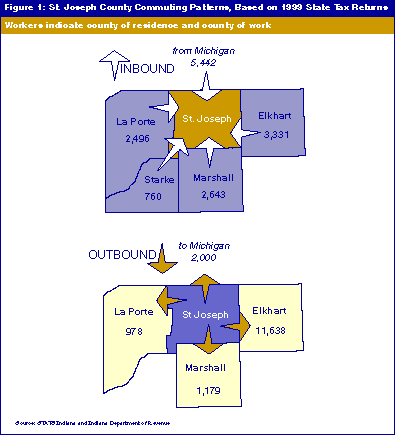Innies and Outies: Commuting to Work in Indiana
Hoosiers work where they live. That is, the majority of Indiana residents work in their home county. But that statewide fact masks the commuting that is common among state-border counties and counties that are job magnets or residence magnets.
Results from Census 2000 (when available in 2002) will provide the most precise and accurate portrait of travel to work. Why? Because the questions on the census long form were tested and constructed to glean accurate commuting data. However, annual data collected from Indiana's state individual income tax returns can provide a useful interim picture of commuting trends. These data are available in aggregated form on STATS Indiana (www.stats.indiana.edu). To understand the information provided, we will dissect the St. Joseph County commuting data as an example. It is a state-border county and also a job magnet in its region.
Based on the 1999 state tax returns, more than 165,000 St. Joseph County residents worked, and of those, 147,000 worked in St. Joseph. The remaining 17,000 St. Joseph County residents commuted out of the county for work, while more than 17,000 residents of other counties (or states) commuted into St. Joseph County to work.
Those county totals can be more finely divided by the actual counties (or states) receiving or sending workers. The majority (16,565) of people commuting into St. Joseph for work lived in four counties adjacent to St. Joseph and the state of Michigan (see Figure 1). Conversely, 17,954 St. Joe residents worked outside that county. More than 14,000 went to Michigan or an adjacent Indiana county.

Caveat Emptor
Four caveats come to mind when using these data:
- Not everyone files a state income tax return, so the number of workers shouldn't be used as an exact number of those employed in Indiana.
- Those filing state tax returns (IT-40) are instructed to enter the county code, not the name of their residence and work counties. The filer must refer to a section of the IT-40 booklet to find the code, increasing the possibility that mistakes will be made with those numbers.
- The number of workers is not comparable to estimates of the labor force from the Bureau of Labor Statistics. The methods of collection are completely different, as are the purposes of the data. For example, place of work and residence for tax purposes are based on a precise date—Jan. 1. The BLS estimates are based on a monthly survey of households.
- Data for a category described as "out of state" refers to workers commuting into or out of St. Joseph County. Yet, the "out of state" category excludes our contiguous neighbors of Ohio, Michigan, Illinois, Kentucky, Wisconsin or Pennsylvania. Detail for those six states is shown separately.
Who are these residents who work or live beyond our neighboring states? Scrutinizing the form (available on the Web, happily, for 1999 and prior tax years) provided some answers. For example, we are instructed to use a two-digit code to indicate the county in which we lived or worked. Two-digit codes for neighboring states are supplied on page 16 of this year's instruction booklet. And if we didn't work or live in one of those states on Jan. 1, we are instructed to use the "other state" code of 00.
Other directives that bear on the use of the commuting data include those relating to residence. We must indicate our county of residence based on where we lived on Jan. 1, even if we moved to a different county in Indiana after that date. Also, if someone lived outside Indiana but had income from Indiana, they are required to fill out an Indiana tax return. The county of work is defined in this same instruction booklet as the county of principal employment on Jan. 1.
Even with these caveats, this work/residence data set has the advantage of being annual, providing a yearly indicator of commuting patterns among and between Hoosier counties and our neighboring states.
